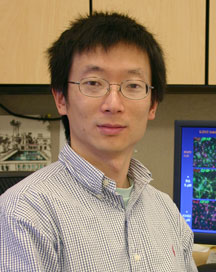

Scientists Develop Improved Medium for Stem Cell Growth and Differentiation
By Eric Sauter
Scientists at The Scripps Research Institute and the Whittier Institute at the University of California, San Diego have developed a simplified, chemically defined medium that allows for the long-term growth and selective differentiation of human embryonic stem cells. Unlike other currently used media, which contain undefined serum products and may vary from batch-to-batch, the new medium provides a basic platform for further study of human embryonic stem cells' self-renewal and specific cell-type differentiation using high-throughput and functional genomic approaches. This development may ultimately lead to novel new therapies.
The study was published on April 21, 2006 in an advance online edition of The Proceedings of the National Academy of Sciences.
Sheng Ding, an assistant professor at Scripps Research who directed the study, says, "Our chemically defined medium for controlling the long-term growth of human embryonic stem cells will not only facilitate their practical application in research and therapy, but also provide an excellent system for studying the underlying molecular mechanisms of self-renewal and differentiation without the unknown and variable factors associated with the current method using feeder cells and serum, which, while providing essential factors, may also complicate or interfere with the culture."
Embryonic stem cells, which are typically derived from the inner cell mass of the blastocyst, a preimplantation embryo of about 150 cells, can be propagated indefinitely and differentiated into all of the cell types of the embryo itself. Embryonic stem cells not only hold considerable promise for the treatment of a number of devastating diseases, but are also an excellent way to study early development and the mechanisms of human illnesses.
In the laboratory, embryonic stem cells are grown in a culture dish containing a nutrient broth. The dish's inner surface is usually coated with a layer of feeder cells, mouse embryonic fibroblast cells that have been treated so they will not divide. This coating releases nutrients and offers an available surface that stem cells can adhere to. However, the new study noted, unknown factors from the feeder cells or contained in the commonly used serum may have undesired activities, which require the addition of other factors to inhibit those effects.
"It is just such an undefined culture condition that is the main source of inconsistency in the large-scale, long-term expansion of undifferentiated human embryonic stem cells," Ding says. "We believe that our chemically defined medium provides a basis for further simplifying culture requirements and will be more effective in the development of practical applications of human embryonic stem cells. It will allow for the future study and control of various signaling inputs that regulate these cells' self-renewal or differentiation without the contamination risks associated with conventional mediums."
Using the new medium, stem cells grow in large compact colonies, express specific markers, and maintain full differentiation potentials similar to the undifferentiated colonies grown under current feeder cell conditions. In addition, the researchers found that several growth factors selectively induced differentiation of human embryonic stem cells toward a number of separate cell types including neural, definitive endoderm, pancreatic, and early cardiac muscle cells.
Researchers included Shuyuan Yao, Shuibing Chen, and Julie Clark of Scripps Research; and Ergeng Hao, Gillian M. Beattie, and Alberto Hayek of the Whittier Institute, University of California, San Diego.
This work was supported by grants from The Scripps Research Institute and The Larry L. Hillblom Foundation.
Send comments to: mikaono[at]scripps.edu

Assistant Professor Sheng Ding directed the new study published in The Proceedings of the National Academy of Sciences. Photo by Kevin Fung.
